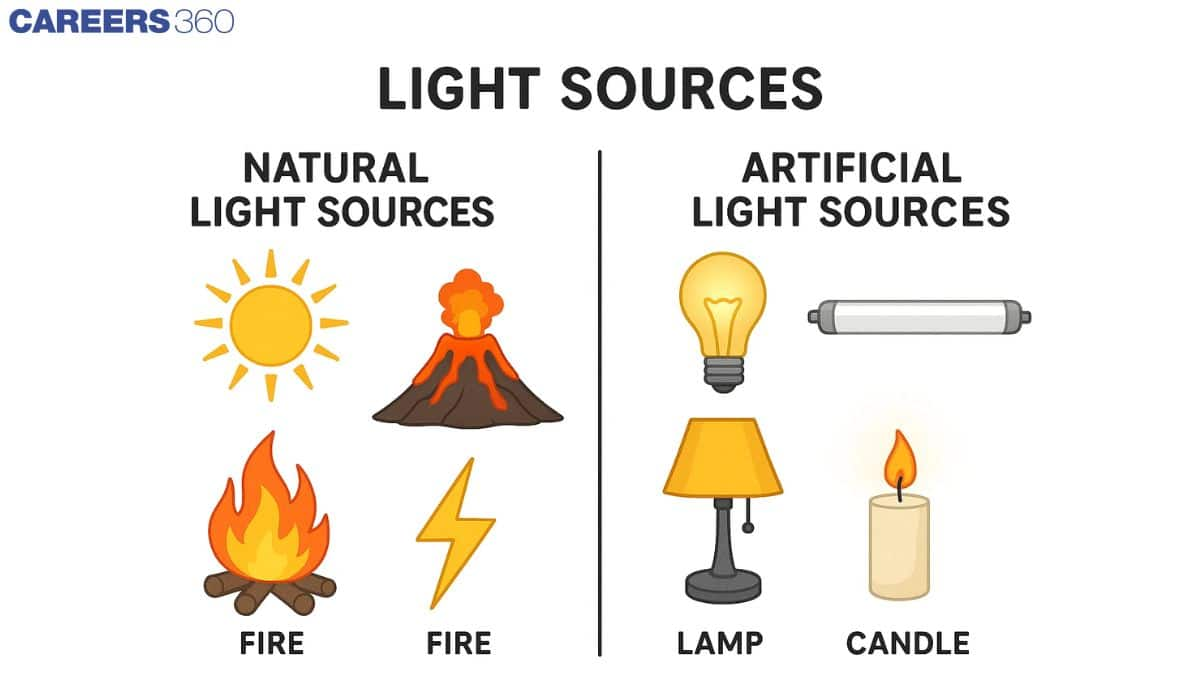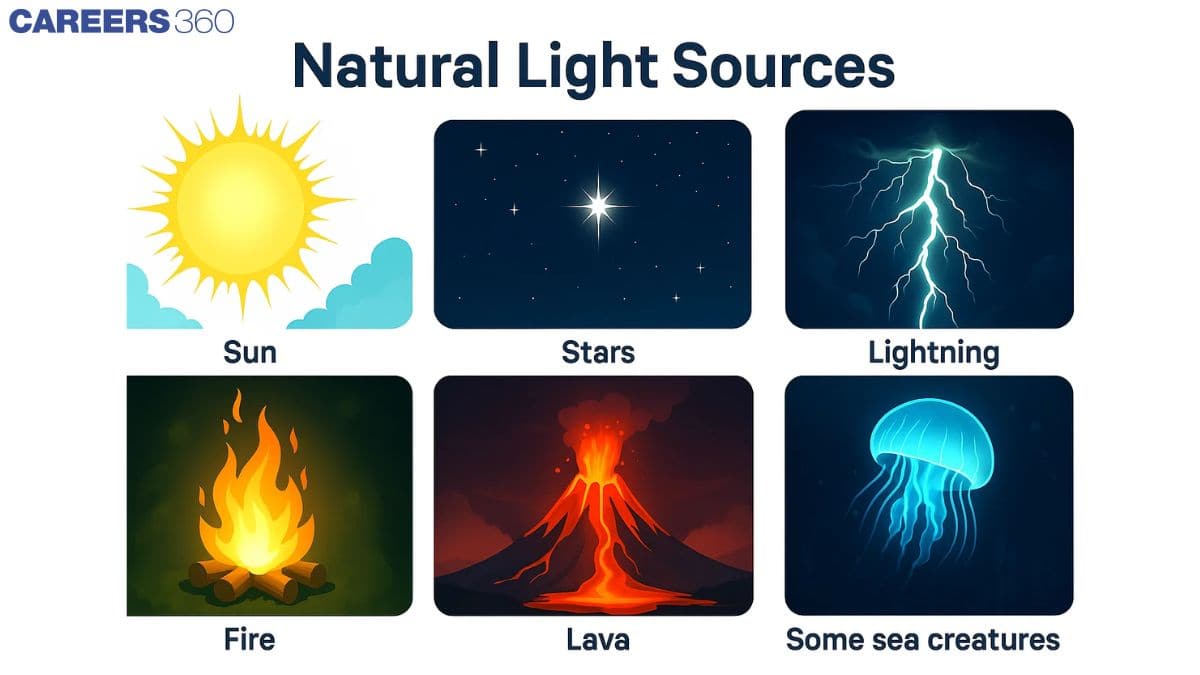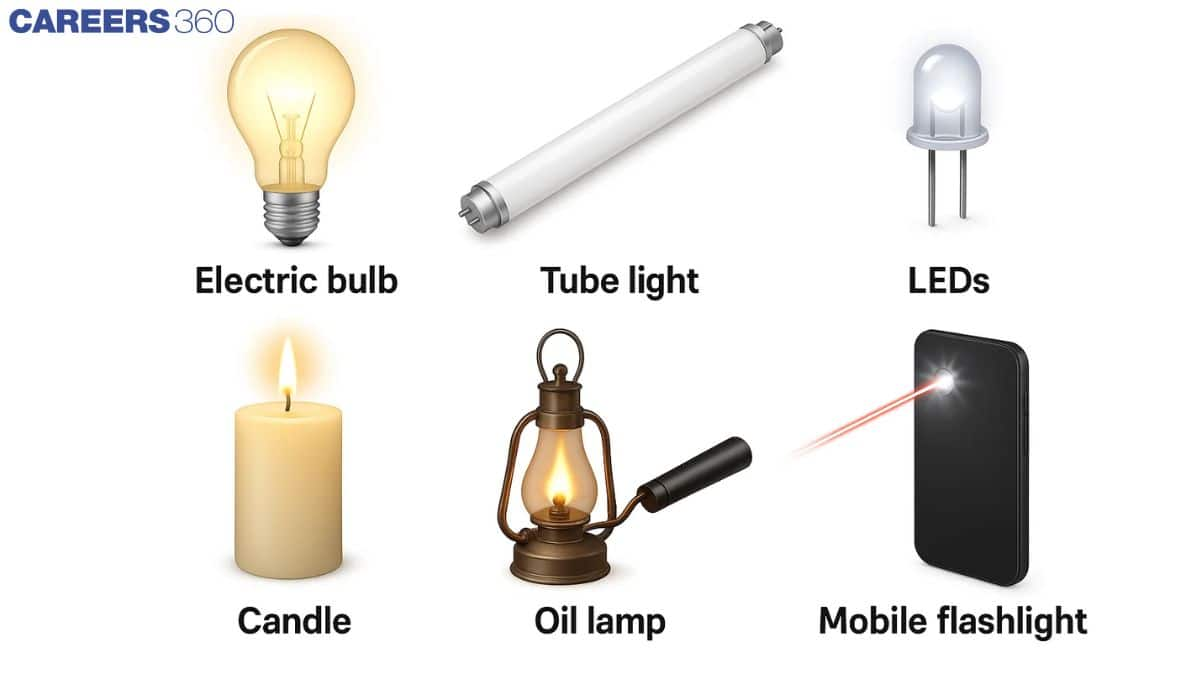Light Sources - Natural Light Sources, Artificial Light Sources, FAQs
Light is what we use daily. It helps us see things around us and keeps our surroundings bright. Plants also use light to grow and prepare food. Light can also be natural or man-made. The Sun, stars, and fireflies are examples of natural light sources. Bulbs, candles, and tube lights are examples of artificial light sources. A natural light source is one found in nature. Artificial light sources are made by people and need energy to work. This article talks about both types of light sources and some simple questions related to them.
This Story also Contains
- What is Light?
- Types of Light Source
- Difference Between Natural and Artificial Light Sources
- Fun Facts About Light

What is Light?
Light is a form of energy that allows us to see. Light moves in a straight line and can travel through air, water, and empty space. In the absence of light, everything would be dark, and our eyes would not be able to perceive it. The Sun is the main natural source of light. Light enables us to see colour, shape, and objects near us. It also helps the plants prepare their food through the process of photosynthesis.

Types of Light Source
Light sources can be grouped into two main types, which are natural and artificial light sources.
Natural Light Sources – Definition and Examples
Natural light sources arise in nature and are not made by human beings. These sources generate light by themselves without any support from electricity or fuels. Natural light is predominantly available during the day, while some sources may be seen at night.

Examples of Natural Light Sources
- Sun – The primary and most powerful source of light on Earth. It gives us daylight and energy.
- Stars – They appear as tiny dots of light in the night sky. They are, in fact, huge spheres of burning gases far away.
- Fire –Natural fire from wood or grass burning also produces some light.
- Lightning – It is a flash in the atmosphere during storms created by an electric discharge.
- Fireflies – The insects that glow through bioluminescence, a natural chemical process.
- Lava – The hot, glowing liquid rock from volcanically active regions can emit light.
- Some sea creatures – Deep-sea creatures like jellyfish can glow in the dark using bioluminescence as well.
Artificial Light Sources – Meaning and Examples
Artificial light sources are man-made. They were developed to bring illumination when natural light is not enogh, particularly at night or dark areas. These source use electricity, chemicals, or fuels to produce light.

Examples of Artificial Light Sources
- Electric bulb – The most common source of light used in homes and schools that works with electricity.
- Tube lights – Long lights to illuminate rooms and halls.
- LEDs – Light-emitting diodes that consume less energy and last for a long time.
- Candle – An ancient way of producing light, burning wax.
- Oil lamp – It burns oil and produces light; it is commonly used in villages.
- Laser lights – A focused beam of light, used in machines, shows, or surgeries.
- Mobile flashlight – A small LED torch attached to mobile phones for emergency work.
Difference Between Natural and Artificial Light Sources
Table below is showing the diffrence between nagtural and artificial source of light.
Natural Light Sources | Artificial Light Sources |
| Found in nature | Made by humans |
| Do not need electricity or fuel | Need electricity, fuel, or batteries |
| Examples: Sun, stars, lightning, fireflies | Examples: Bulb, candle, LED, tube light |
| Work on their own (no switch or control) | Can be turned on or off by us |
| Mostly available during the daytime or naturally | Available anytime as per need |
| Cannot be created or controlled by people | Can be created, controlled, and used as needed |
Fun Facts About Light
- It travels at a speed of 300,000 kilometres per second in space.
- Sunlight takes approximately 8 minutes to reach the surface of the Earth.
- The Moon does not emit its own light but only reflects the light coming from the Sun.
- Fireflies and some other sea creatures have the ability to emit light naturally; the property by which this is achieved is called bioluminescence.
- The colours of white light consist of seven distinct colours, which you see in a rainbow.
- Light travels in a straight line unless it is bent by something, such as water or a lens.
- LED lights have a longer life and consume less power as compared to incandescent bulbs.
Frequently Asked Questions (FAQs)
There are two types of light sources: Natural and Artificial Sources.
Two types of sources of light- Natural & Artificial Sources.
Two sources of light- Sunlight and Fire
The 10 artificial sources of light are given below:
- Candle
Lamp
Bulb
Torch
LED’s
Lighter
Fire
Lasers
Flame by matches
Light from TVs & Phones
These are also known as different types of artificial light.
The moon does not have its own light. So, it reflects the light from the Sun and acts as one of the natural light sources on the Earth.
A light source is anything that produces a light. Or we can also say that light originates from light sources.
It helps our body to produce Vitamin D, it improves the immune system, sleeps, it even makes us happier.
Sun, Flame, Electric Bulb, etc. are the sources of light energy.
Natural light comes from natural sources like the Sun. Whereas artificial light comes from artificial sources like Torch.